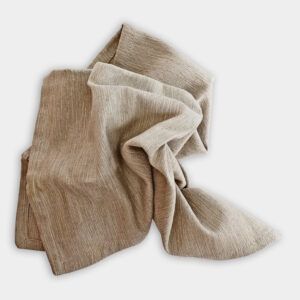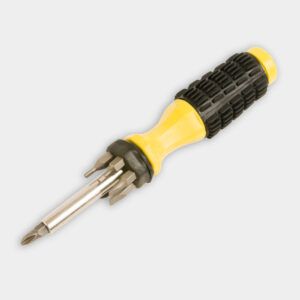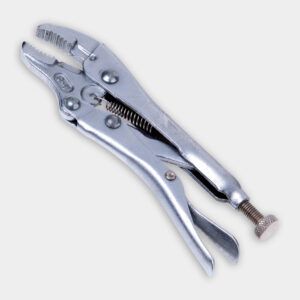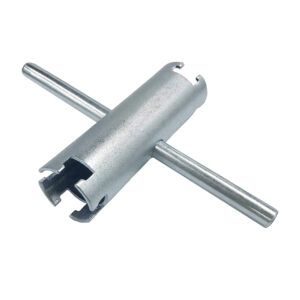Project details
Skill
Cost
Estimated Time
Replacing a bathtub drain is a manageable do-it-yourself (DIY) project that can solve common tub issues such as leaks, clogs, or broken drain stoppers. With the right tools and a bit of know-how, you can get your tub back in working order and prevent water damage. Get step-by-step instructions in our guide below, and follow along in the video above as This Old House plumbing expert Richard Trethewey replaces a bathtub drain.
Understanding Your Bath Waste and Overflow System
The bath waste and overflow system is a primary component of your bathtub’s plumbing. It consists of several parts that work together to control water flow and prevent flooding. Here are the key components you’ll encounter when replacing a bathtub drain:
- Drain shoe: Located at the bottom of the tub, this part connects the visible drain to the plumbing beneath.
- Linkage assembly: This connects the overflow plate to the drain stopper, allowing you to open and close the drain.
- Overflow plate: Positioned near the top of the tub, it prevents water from spilling over if the tub is overfilled.
- Trap: The trap is a curved section of pipe that prevents sewer gases from entering your bathroom.
Importance of the Overflow
The overflow is a critical safety feature in your bathtub. As Tretheway explains, it prevents water from overflowing if you forget about a running faucet or when a person splashes out water entering the tub. This simple mechanism can protect your floors from water damage and potential structural issues, plus save you the hassle of an inconvenient cleanup.
Preparing for the Bathtub Drain Replacement
Before replacing your bathtub drain, assess the situation and gather the necessary tools and materials. As seen in the video above, this project goes smoother if you have someone helping you.
Assessing the Drain
Inspect your current drain for issues such as these:
- Broken or missing drain screens
- Faulty stopper mechanisms
- Leaks or water damage beneath the tub
- Rust or corrosion
Gathering Tools and Materials
To replace your bathtub drain, you’ll need the following tools and materials:
- Bath waste and overflow kit
- Penetrating oil
- Pliers
- Plumber’s putty
- Rag for cleanup
- Screwdriver
- Strainer wrench
Choosing the Right Drain Replacement Kit
There are several options available for bath waste and overflow kits, including the following:
- PVC kits that can be glued for a leak-proof seal
- Toe-touch drain systems that eliminate the need for a visible stopper
- Traditional metal kits with a trip lever mechanism
Removing the Old Drain
The first step in replacing your bathtub drain is removing the old drain components. This process can vary depending on the age and condition of your existing drain.
Accessing the Drain
First, remove the two screws securing the overflow plate using a screwdriver. If possible, unscrew the drain shoe from above using pliers or a drain wrench. For stubborn drains, you may need to access the plumbing from below the tub.
Dealing with Stuck Drains
If your drain is seized due to age or corrosion, you may need to take these additional steps:
- Use a specialized drain removal tool to grip the inside of the drain.
- Apply penetrating oil to loosen corroded parts.
- In extreme cases, you might need to cut out the old drain from below using a reciprocating saw.
Cleaning the Area
Once the old drain is removed, clear away any old plumber’s putty or debris from the drain opening. Clean the surrounding area to ensure a good seal for the new drain. Inspect the drain hole for any damage that might need repair before installation.
Installing the New Drain
After removing the old drain and cleaning the area, you’re ready to install the new bath waste and overflow system.
Assembling the New Kit
- Loosely assemble the components of your new bath waste and overflow kit.
- Adjust the linkage to fit your tub’s depth.
- Apply the plumber’s putty to the underside of the new drain shoe.
Positioning the Components
- Insert the drain shoe into the tub’s drain hole from above.
- From below, align the rubber gasket and drain elbow with the shoe.
- Have someone in the tub catch the threads and tighten the drain shoe using pliers or a strainer wrench.
Connecting the Overflow
- Align the overflow assembly with the tub’s overflow hole.
- Attach the linkage assembly to the trip lever faceplate.
- Insert the plunger linkage into the overflow hole.
- Secure the overflow plate with screws.
Finalizing the Installation
- Tighten all slip nuts and washers to ensure a watertight seal.
- Thread the new drain into the existing pipes.
- Install the strainer drain plate.
- Test the new drain and stopper to ensure proper function.
Troubleshooting Common Issues With Bathtub Drains
Even with careful installation, you might encounter some issues. Here are some common problems and their solutions.
Leaks
Here are some tips to fix any leaks:
- Check all connections and tighten them as necessary.
- Ensure proper application of plumber’s putty around the drain shoe.
- Inspect gaskets for damage and replace them if needed.
Improper Drainage
Here’s how to deal with improper or slow bathtub drainage:
- Verify that the new drain is properly aligned with the existing pipes.
- Clear any debris that may have fallen into the pipes during installation.
- Adjust the linkage if the stopper isn’t sealing correctly.
Misaligned Components
Below is how you can check for misaligned components:
- Double-check measurements and adjust the overflow height if necessary.
- Ensure the trip lever is properly connected to the linkage assembly.
- Realign the drain shoe if it’s not sitting flush with the tub.
Replacing an Old Trip Lever Mechanism
While replacing a bathtub drain, you might find that the trip lever mechanism needs updating as well. Here’s what to do.
Removing the Old Trip Lever
- Unscrew the cover plate from the overflow.
- Extract the linkage and plunger carefully.
- Clean the area around the overflow hole to remove buildup.
Installing the New Trip Lever
- Insert the new linkage and plunger into the overflow hole.
- Attach the new cover plate with screws.
- Test the lever to ensure smooth operation.
Adjusting the Linkage
- Adjust the length of the linkage to fit your tub depth.
- Ensure the plunger moves freely within the overflow pipe.
- Tighten any connections for a secure fit.
Maintenance Tips for a Bathtub Drain
Follow these guidelines to keep your new bathtub drain functioning properly:
- Clean the drain regularly to prevent clogs.
- Avoid using harsh chemical cleaners that can damage the finish or components.
- Periodically check for leaks and tighten connections as needed.
- Lubricate moving parts of the stopper mechanism annually.
Video Transcript
RICHARD:
You must be Chris.
CHRIS:
You must be Richard. How are you?
RICHARD:
Good, how are you? Thanks for coming.
CHRIS:
Thanks for coming.
RICHARD:
Glad to be here. This looks like a typical 50s ranch.
CHRIS:
Certainly is. My fiancé bought it about a year ago. Great. We have a project for you in the bathroom. You want to join me?
RICHARD:
Great. Always the bathroom or the basement.
CHRIS:
All right. Nice new tile flow they put in.
RICHARD:
Beautiful. You guys do it yourself?
CHRIS:
Awesome. All grouted. Nice. Over here in the pink tub.
RICHARD:
Look at this. You know this you think this is pink but actually you know what they called it back then? They called it Bermuda Coral. It sounded a lot better than pink I guess. All right so what do you got?
CHRIS:
So the screen broke, the screw that holds it in sheared. Okay. And the overflow doesn’t hold water. There’s a little gunked up down there too.
RICHARD:
All right so this thing is actually called the Bath Waste and Overflow and it is really secretly quietly one of the most important safety devices in your entire house plumbing wise. Because it’s got this overflow right here. Now for the obvious reason if you were filling the tub and you forgot about it you wouldn’t want it to overflow. But much more commonly you fill the tub and then you get in it and people displace all that water and without the overflow it could come right down to the floors below. All right so let me look down below and see what we have for access. I think we can change this up.
Great. All right well I love your basement.
CHRIS:
Thank you. So what’s the prognosis?
RICHARD:
All right we’re underneath your bathtub. You can see right here here’s the thing called the bath shoe. That’s where that screen is that’s broken. All right. Here’s the tea. There’s the overflow. Comes down into a trap. You can see the trap. The drain goes this way. You’ve got wide open access. We can get at all parts of it. So it means we can change out the whole unit if we choose to.
So I brought you some choices here. This is the unit you’ve got right here. There’s that bath shoe. You can see here’s the new screen right here. And now I’m going to pull this apart.
What you don’t see inside of any bath waste is a thing called this trip lever. Right here. Let me just pull this apart. Look at this long linkage. See that little piston right there? Cool. All we’re trying to do with this little trip right here is to make this piston. Look right in there. Do you see how it just blocks the water? And if I lift this up you see how it opens it? So that’s how the water goes up and out. So we just have to adjust this linkage.
Okay. And then this is that overflow I was talking about. It’s designed with an opening intentionally so that that water will come up and down through that overflow.
CHRIS:
Great.
RICHARD:
All right. So this is the standard one. This is one I’ve used forever. We can just replace this right here.
I did want to introduce a new offering in the marketplace recently is this. This one is all made out of plastic and PVC so it’s really good for new work and it can all be glued together so there’s no compression connections underneath. It’s got your overflow but it’s got a little different mechanism. It doesn’t have the trip. It has a thing called a toe touch.
Okay. So there’d be no screen but it would mean that the water would stop or open this way.
CHRIS:
Oh great.
RICHARD:
So this is that and what they actually have now is this. If we didn’t have this kind of access right here and we just wanted to fix the stopper, this is made to replace this top part of the shoe. So it would come down like this and this is what you’d see from above and so in a retrofit we could fix the drain portion of this thing but it would mean that this would be left as an obsolete thing which would be confusing. I think as a pro I would just change this whole thing out with your help.
CHRIS:
Sounds good.
RICHARD:
All right so you’re going to start by going upstairs. There’s two screws that are on this plate right here. All right. Why don’t you unscrew them and I’ll start working down here.
CHRIS:
Sounds good. Got one out.
RICHARD:
Okay. They both out?
CHRIS:
Both out.
RICHARD:
We want to get the bath shoe unscrewed. Look down in there and just see if we can go counterclockwise and I want you to see if it’ll spin.
CHRIS:
This thing is seized in there.
RICHARD:
That’s okay. I’m coming up. All right so it’s not giving in huh?
CHRIS:
Really seized in there.
RICHARD:
All right let me jump in there okay. It is not unusual. That thing’s been in there for what, 70 years at least. So time for some reinforcements. Now they make a special right here that I could expand to try and squeeze on the inside. But I don’t think that’s going to do it. So I’m going to use these heavy irons. That’s going to let me come down in here. And now with a wrench try to transfer my effort to spin.
Nope.
All right so this is the real life of retrofit and old work plumbing. So one thing I can do is because I got access below it I could take a reciprocating saw and I can cut this piece out from below. So we’re not done yet.
Good. There’s one.
Okay so this and there’s the overflow. All right RICHARD: I’m gonna I’m gonna give it a little pop and it’ll come to you and then after that clean it up so we can get rid of the all the old putty.
CHRIS:
All right sounds good. Got it.
RICHARD:
Okay clean up the old putty and then we’ll put the new work in.
CHRIS:
All right. So this is adjustable so I’m just gonna make these nuts up loosely.
RICHARD:
You can see there’s a compression gasket and a nut.
All right CHRIS you still up there?
CHRIS:
Yep.
RICHARD:
All right you’ve got two jobs. One is to put some putty onto that spud that’s going to come down into the bath shoe.
All right. Should be putty right next to you.
CHRIS:
Yep.
RICHARD:
I’m going to hold this up in place and you’re going to try to catch this thread to the bath shoe.
Okay great hold that push it down a little bit. I have a gasket I’ve got to put on and then I’m going to hold this up in place.
Now I’m going to push it up a little bit. I want you to try to catch the threads. Spin the threads as you can. You feel it. Is it going okay?
CHRIS:
It’s going smooth now. Great. All right switching to the wrench.
RICHARD:
Okay. All right I’m going to hand this overflow to you and I want you to catch the two screws.
Okay. Let’s try see what we have for length. This thing’s adjustable too for different tubs.
How’s that?
CHRIS:
Right there. Hold on one second.
RICHARD:
So all right the time for the test. Now I adjusted that linkage before we put it back in for that deeper tub and it seems to be holding fine but if it doesn’t you saw that linkage you can tighten it.
All right homeowners always get the honors.
CHRIS:
Perfect.
RICHARD:
Awesome it’s holding.
CHRIS:
There it is. Perfect. You are ready to take a bath in your Bermuda coral bathtub.
RICHARD:
Awesome. Enjoy.
CHRIS:
Thanks. Thanks my friend. Have a good one.




